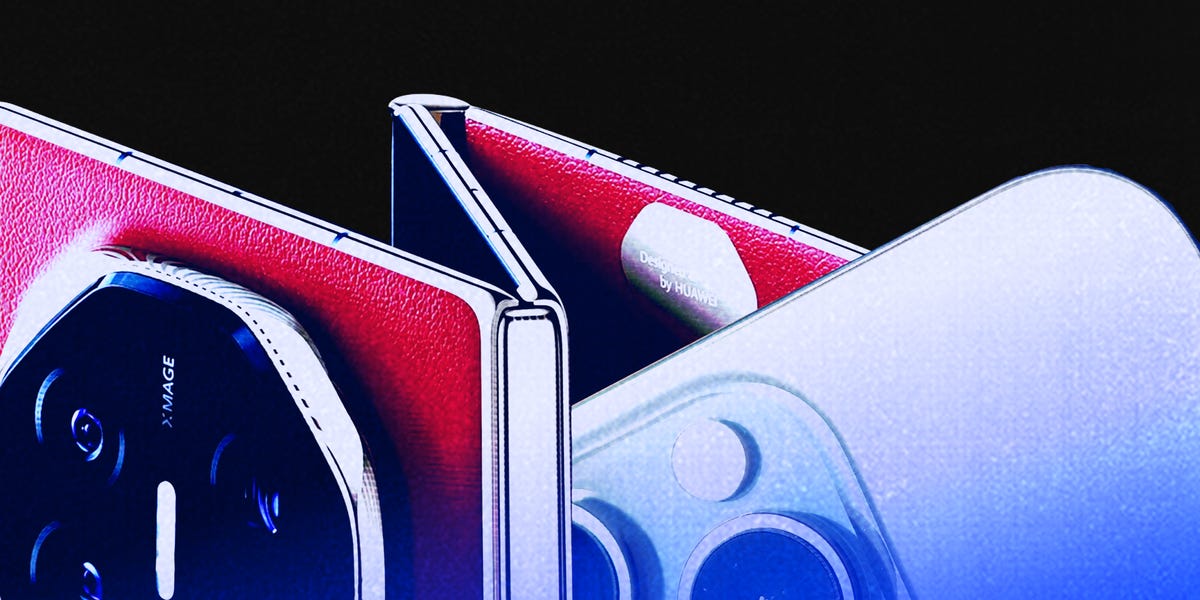Huawei’s triple smartphone, the Mate XT, launched on Friday in China, just like Apple’s 16 – and it has become a battle between technology rivals in the world’s largest smartphone market, where Apple is working to restore. slippery slope.
Competition has been tough over the past year, and Huawei is looking to one-up Apple with its latest launch.
Hours after Apple unveiled its iPhone 16 models earlier this month, Huawei announced the Mate XT will drop on the same day.
Huawei said it secured more than 2.7 million reservations for the two smartphones in the first few hours, and the $2,800 device was listed at three times its retail price on retail sites. Before the launch date, the company said that the first orders crossed 6.5 million units.
For Americans, there will be no temptation to choose the Mate XT over the iPhone 16, as Chinese smartphones have not been available directly from the American company since they were placed on the “List of Organizations” in 2019.
Huawei’s Mate XT triple smartphone has secured millions of pre-orders. John Ricky/Anadolu via Getty
But in China, Huawei began delivering its new phones to customers who ordered them shortly after 10 a.m. local time on Friday, CNBC reported from Beijing. While people have been queuing at Apple stores since 5:30 a.m. to be the first in line for the new iPhone when stores opened at 8 a.m., Huawei stores in Beijing and Hefei had no lines, news reports said.
Reuters reported that it saw about 30 people queuing at Huawei stores in Shenzhen and Beijing, compared to about 100 Apple customers queuing outside the Beijing store.
Customers in Guangzhou, China, lined up to enter an Apple store. John Ricky/Anadolu via Getty
The split may be due to the way Huawei distributed the first batch of Mate XT sales. Some of the company’s biggest players told Reuters they were disappointed to find they couldn’t get in to buy the dual-use device, which was apparently reserved for pre-orders.
Huawei did not immediately respond to a request for comment outside local business hours.
Important differences in price – and design
To make the competition between the companies more intense, both brands are introducing their own artificial intelligence features.
Mate XT includes generative-AI and satellite communication features. Meanwhile, Apple has made extensive announcements of its gen-AI offerings, collectively called Apple Intelligence, but those features won’t begin rolling out to the iPhone 16 until October.
The phones are incredibly diverse in terms of looks and price, with Huawei benefiting on social media from its eye-catching three-fold design, which allows the phone to grow into a tablet-sized device. with a 10.2-inch screen.
Huawei’s Mate XT hit the shelves on Friday as online sales prices soared. CFOTO/Future Publishing via Getty Images
It’s one step beyond foldable phone designs, and the Mate XT’s $2,800 price tag means consumers will have to pay a lot to be among the first to own the phone. Apple’s iPhone 16 lineup starts at $800.
Apple’s hardware design is relatively repetitive, but there are notable changes. The iPhone 16 offers a new “camera control” button and brings the “action” button that was only available on the iPhone 15 Pro models to the entry-level iPhone 16.
The new “camera control” button for the iPhone 16. apple
While Apple is betting that subtle tweaks to its design and major changes to its software will sway consumers to upgrade to the iPhone 16, there are signs that we could see a different design. in the coming years.
Apple, The Information reported in January, has been exploring two foldable phones after mulling over the idea for years. The tech giant, which normally likes to wait to launch a new category until it feels ready to take control, will be behind the game as competitors have already introduced similar products, including Samsung and Google Pixel available in the US.
In the meantime, the company wants to introduce a much thinner iPhone Air next year, Bloomberg reported last month.
Apple is facing big problems in China
In 2023, Apple became the best-selling smartphone in China, a major achievement that came years after the US imposed sanctions on Huawei in 2019, which shut down the the Chinese company not to get the newest semiconductors. In response, Huawei developed its own processors for use in a line of smartphones released in April.
But Apple’s victory was short-lived as the Chinese company’s iPhone sales fell 24% in the first six weeks of 2024, according to data from market research firm Counterpoint Research. Vivo has become the new top smartphone vendor in the region.
Since then, Apple has faced questions from Wall Street during its earnings calls about the company’s smartphone sales in China.
Vivo maintained its lead in China in the second quarter, followed by Apple and Huawei, Counterpoint Research found. Apple saw a decline in market share of 5.7% year-on-year in the quarter, while Huawei’s sales rose nearly 45% in the same period, the firm’s data showed.
Some on Wall Street, such as the Wedbush Securities analyst firm, are of the opinion that Apple may turn the corner in China with the iPhone 16.
The firm predicted earlier this month that the iPhone 16 will be “Apple’s most successful iPhone experience in its history as Apple Intelligence will be the platform to introduce the AI Revolution to consumers around the world.”
But with fierce competition for the launch date in China, you can bet Wall Street will be looking to see if Huawei complicates Apple’s comeback story.
